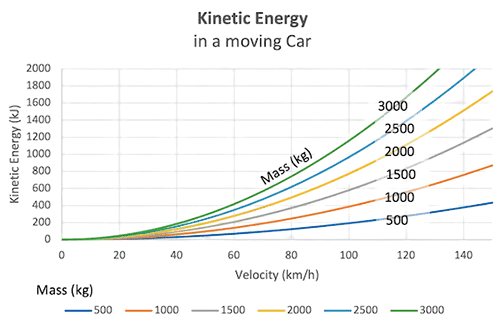Kinetic Energy Calculator
Determine Kinetic Energy in Joules for Any Moving Object
📋How to Calculate Kinetic Energy
-
Enter the mass of the object in kilograms.
-
Enter the velocity in meters per second.
-
Click "Calculate" to find kinetic energy in joules.
To find the kinetic energy (E_k), enter the object's mass and its current velocity. The calculator applies the fundamental physics formula: E_k = \frac{1}{2}mv^2.
Whether you are calculating the impact force of a vehicle or the energy of a projectile, this tool provides results in Joules (J), Kilojoules (kJ), or Foot-pounds (ft-lb).
Useful Tips💡
-
Always convert speed from km/h or mph to m/s for standard SI calculations.
-
Ensure the mass is of the object alone, excluding external forces.
Mistakes to Avoid ⚠️
- Forgetting to square the velocity in manual calculations.
- Confusing Kinetic Energy (scalar) with Momentum (vector).
- Using weight (Newtons) instead of mass (kg) - remember m = W/g.
How Are Kinetic Energy Calculations Performed?
The kinetic energy solver using the formula KE = 1/2 mv², with m = mass in kilograms, and v = velocity in meters per second. The kinetic energy (KE) is then presented in joules (kg·m²/s²). For instance, the KE of a 2 kg object moving at 4 m/s converts to 2 kg × 4 m/s; KE = 1/2 × 2 × 4² = 16 joules. The formula is derived from classical mechanics assumptions. 
Practical Applications📊
-
Evaluate moving vehicles to determine their safety aspects.
-
Evaluate sports energy to better prepare an athlete.
-
As part of a physics experiment or process to conduct study on motion.
Questions and Answers
What is a kinetic energy calculator?
A kinetic energy calculator determines the energy of any moving object. It does this by using the object’s mass and its velocity. It uses the kinetic energy equation, KE = 1/2 mv² to provide the energy in joules. This is a useful calculator for students, engineering, or anybody exploring any movement in motion, KE can be determined easily and quickly for practical use.
How do I calculate kinetic energy?
To calculate the KE using the calc, you enter the mass of the object in kilograms and its velocity in meters per second; you will enter the mass and velocity, the calculator processes the data through KE = 1/2 mv² converting it to kinetic energy joules. So for instance, a 1000 kg car going 3 m/s would have KE = 1/2 x 1000 x (3 x 3) = 4500 joules.
How is kinetic energy measured?
Kinetic energy is measured in joules (J), or kg·m²/s² in the SI system. This is how we measure the energy that an object has due to motion, based off of the KE equation. For example, a 0.5 kg ball traveling at 10 m/s would have KE = 1/2 × 0.5 × 10² = 25 joules.
Can kinetic energy be negative?
No. Since mass is positive and velocity is squared, kinetic energy is always zero or a positive value.
How does mass affect kinetic energy?
Kinetic energy is directly proportional to mass. If you double the mass of an object moving at the same speed, you double its energy.
What is the difference between Potential and Kinetic energy?
Potential energy is stored energy based on position (like height), while kinetic energy is energy possessed due to motion.
What is the kinetic energy formula that the calculator uses?
The formula for kinetic energy is KE = 1/2mv² where m is mass (in kilograms) and v is velocity (in meters per second), which will give the result in joules. As an example, suppose we have a mass of 50 kilograms moving at 18 meters per second. KE would be KE = 1/2 × 50 × 18²= 8100 joules. This formula, like the other formulas discussed previously, has been utilized in classical mechanics and is approved by the American Physical Society as the standard to use for physics calculations, and thus CalcMate® will use this formula to provide accurate results.


